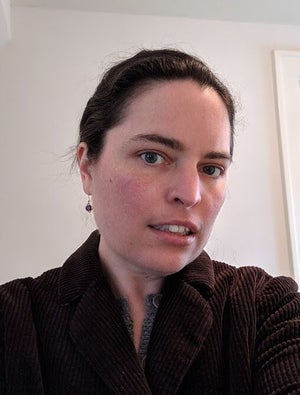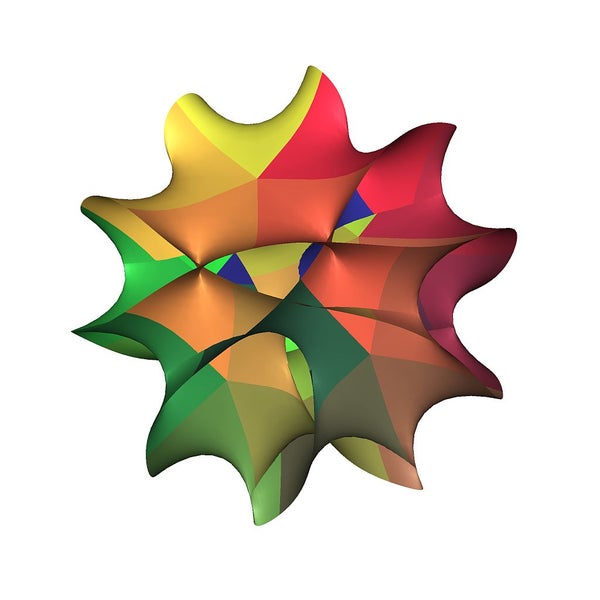This article was published in Scientific American’s former blog network and reflects the views of the author, not necessarily those of Scientific American
On this episode of our podcast My Favorite Theorem, my cohost Kevin Knudson and I had the pleasure of speaking with Ursula Whitcher, a mathematician who works for Mathematical Reviews. You can listen to the episode here or at kpknudson.com, where there is also a transcript.

Mathematician Ursula Whitcher. Credit: Ursula Whitcher
On supporting science journalism
If you're enjoying this article, consider supporting our award-winning journalism by subscribing. By purchasing a subscription you are helping to ensure the future of impactful stories about the discoveries and ideas shaping our world today.
Dr. Whitcher didn’t pick one particular theorem to talk about but a genre of theorems in a research area called mirror symmetry. This is a branch of math that grew out of theoretical physics. The original setting for mirror symmetry was string theory. String theorists noticed that they could start with a certain type of 6-dimensional manifold called a Calabi-Yau manifold (sometimes called a three-fold because its six real dimensions correspond to three complex dimensions; basically, algebraic geometers count funny) and associate a set of numbers to it based on its geometry. Then if they looked at a “reflection” of those numbers, they could find another Calabi-Yau manifold associated to those reflected numbers. That relationship between two dissimilar manifolds is the “mirror symmetry” sought in this field.
Since the initial observation of these relationships, the idea of mirror symmetry has flourished in many different mathematical settings. Kevin Hartnett wrote about homological mirror symmetry, one of these settings, for Quanta Magazine last year. Dr. Whitcher and Charles Doran wrote an article about mirror symmetry, including a combinatorial construction of two mirror pairs, for Mathematics Magazine (pdf here). Timothy Perutz wrote about the current state of the mirror symmetry field for the Notices of the American Mathematical Society. Those articles are good places to start if you want to learn more about the mathematics and physics foundation of this field.
In each episode of the podcast, we ask our guest to pair their theorem with food, beverage, art, music, or other earthly delight. Dr. Whitcher chose fancy ramen. You’ll have to listen to the episode (preferably with a warm bown of tasty noodles) to learn why they make such a good pair.
You can find Dr. Whitcher at her professional and personal websites. She is @superyarn on Twitter. Dr. Whitcher is a prolific writer not just of math research but of fiction and poetry as well. Her poetry has been featured on JoAnne Growney’s math poetry blog, and her fiction recently appeared on the Lesbian Historic Motif podcast.
You can find more information about the mathematicians and theorems featured in this podcast, along with other delightful mathematical treats, at kpknudson.com and here at Roots of Unity. A transcript is available here. You can subscribe to and review the podcast on iTunes and other podcast delivery systems. We love to hear from our listeners, so please drop us a line at myfavoritetheorem@gmail.com. Kevin Knudson’s handle on Twitter is @niveknosdunk, and mine is @evelynjlamb. The show itself also has a Twitter feed: @myfavethm and a Facebook page. Join us next time to learn another fascinating piece of mathematics.
Previously on My Favorite Theorem:
Episode 0: Your hosts' favorite theorems Episode 1: Amie Wilkinson’s favorite theorem Episode 2: Dave Richeson's favorite theorem Episode 3: Emille Davie Lawrence's favorite theorem Episode 4: Jordan Ellenberg's favorite theorem Episode 5: Dusa McDuff's favorite theorem Episode 6: Eriko Hironaka's favorite theorem Episode 7: Henry Fowler's favorite theorem Episode 8: Justin Curry's favorite theorem Episode 9: Ami Radunskaya's favorite theorem Episode 10: Mohamed Omar's favorite theorem Episode 11: Jeanne Clelland's favorite theorem Episode 12: Candice Price's favorite theorem Episode 13: Patrick Honner's favorite theorem Episode 14: Laura Taalman's favorite theorem Episode 15: Federico Ardila's favorite theorem Episode 16: Jayadev Athreya's favorite theorem Episode 17: Nalini Joshi's favorite theorem Episode 18: John Urschel's favorite theorem Episode 19: Emily Riehl's favorite theorem Episode 20: Francis Su's favorite theorem Episode 21: Jana Rordiguez Hertz's favorite theorem Episode 22: Ken Ribet's favorite theorem Episode 23: Ingrid Daubechies's favorite theorem Episode 24: Vidit Nanda's favorite theorem Episode 25: Holly Krieger's favorite theorem Episode 26: Erika Camacho's favorite theorem Episode 27: James Tanton's favorite theorem Episode 28: Chawne Kimber's favorite theorem Episode 29: Mike Lawler's favorite theorem Episode 30: Katie Steckles' favorite theorem Episode 31: Yen Duong's favorite theorem Episode 32: Anil Venkatesh's favorite theorem Episode 33: Michèle Audin's favorite theorem Episode 34: Skip Garibaldi's favorite theorem Episode 35: Nira Chamberlain's favorite theorem Episode 36: Nikita Nikolaev and Beatriz Navarro Lameda's favorite theorem Episode 37: Cynthia Flores' favorite theorem Episode 38: Robert Ghrist's favorite theorem Episode 39: Fawn Nguyen's favorite theorem
